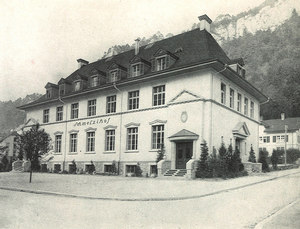
Unternavigation
Business Associations
Business associations represent different, even opposing social policy interests. They often resist proposals to expand the welfare state, particularly when these contain measures that entail new payroll taxes. However, they have also supported the development of social security to a certain extent. Employers likewise took their own initiatives in this domain.
The most important business associations were founded at the end of the 19th century – a time characterized by a moderate expansion of federal powers, growing international competition and the rise of the workers’ movement. The oldest employer association, the Swiss Federation of Commerce and Industry (SHIV), was established in 1870 and in 2000 merged with the Society for the Promotion of the Swiss Economy founded in 1942, becoming economiesuisse. The second Swiss peak business group, the Federation of Swiss Employers’ Associations, was created in 1908. It was renamed Swiss Employers’ Association (SAV) in 1995. Sector and regional associations organize affiliated firms. The SHIV and SAV primarily represent the interests of the export industry and major service companies (such as banks and insurance firms). The SHIV is particularly concerned with economic issues (economic and monetary policy, as well as trade policy) while social policy and labor market fall within the remit of the SAV. Small and medium-sized companies that produce predominantly for the domestic market are represented by the Swiss Trades and Crafts Association (Gewerbeverband, SGV) founded in 1879.
Despite certain competition and occasional differences in interests, such as between the export and domestic industries, the umbrella organisations of Swiss employers often co-operate closely. The aim is to seek a degree of employer cohesion in dealing with employee organisations and the state, allowing business to act as a substantial stakeholder in matters of economic and social policy. Since the beginning of the 20th century, and to an even more systematic extent following the Second World War, employer representatives have been directly involved in drafting federal legislation as part of non-parliamentary expert commissions.
Employers’ associations took a generally reluctant, even dismissive stance toward the first pushes for social security schemes. They defended a type of economic liberalism that sought to limit state intervention as far as possible. Social expenditures were also to be capped, particularly wage contributions borne by employers. Business was also keen to prevent the state from competing in areas where the private sector had already developed occupational provision and healthcare. The employers’ associations were therefore for a long time skeptical of the state providing old age insurance and they played their part in delaying the acceptance of compulsory health insurance until the 1990s and maternity insurance until 2004.
Nonetheless, employers were certainly interested in developing some forms of social insurance. This was the case in 1924, when the employers’ associations supported the bill on unemployment insurance. The reasoning behind their support was that the provisions provided access to benefits that improved work discipline and regulated the labor market in a way that employers were not forced to dismiss their staff in the event of falling production. Individual employers, particularly in the textile and clothing industry, founded their own unemployment funds in order to retain workers and hinder the development of trade union funds.
In the 1930s, employers’ associations also established family compensation funds, especially in the construction and metal industry. Employers thereby sought to strengthen their collective action and engage in a more flexible wage policy: Indeed, family allowances were a means of granting targeted wage increases (particularly for fathers) that could be reversed relatively easily. These funds played a significant role in the introduction of the income compensation scheme (EO) during the Second World War (1939/1940) and served as a model for the introduction of old age and survivors’ insurance (AHV) in 1947. Some employers’ associations, however, would have preferred using the structures and finances of EO for unemployment insurance too; this way, they would have had control over a category of social security which was largely in trade union hands.
The interests and initiatives of employers concerning social security were regular topics of internal debates within the associations. For instance, within the SAV, the construction industry demanded an improvement to unemployment compensation due to poor weather, while the majority of other sectors were strictly against this idea until the 1980s. Likewise, employers who mainly employed women in their companies – such as in the textile industry – were in favor of improving the situation of part-time workers by way of unemployment insurance, in opposition to the association on the whole. There was also disagreement regarding the benefits and relevance of employer equalization funds.
Employers have been advocating a restriction of social benefits since the crisis of the mid-1970s, and particularly since the 1990s. Employer organisations have since repeatedly pushed for the liberalization of the Swiss economy, lamenting the high costs of social insurance. They have been in favor of a range of reforms aimed especially at reducing social security expenditure since the 1990s (1990–2000).
Literatur / Bibliographie / Bibliografia / References: Mach André (2002), Associations d’intérêts, In U. Klöti, P. Knoepfel, H. Kriesi, W. Linder & Y. Papadopoulos (Eds.), Handbuch der Schweizer Politik (pp. 299-336). Zürich ; Mach André (1999), Globalisation, néo-libéralisme et politiques publiques dans la Suisse des années 1990, Zürich; Humair Cédrid et al. (2012), Les organisations patronales suisses entre coordination économique et influence politique, Vingtième Siècle. Revue d'histoire, 115, 115-127.
(12/2014)




